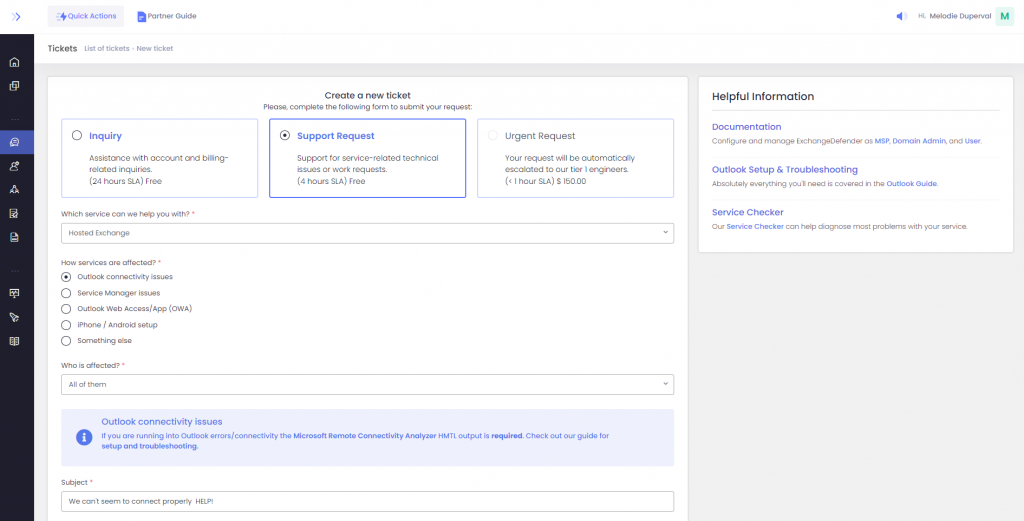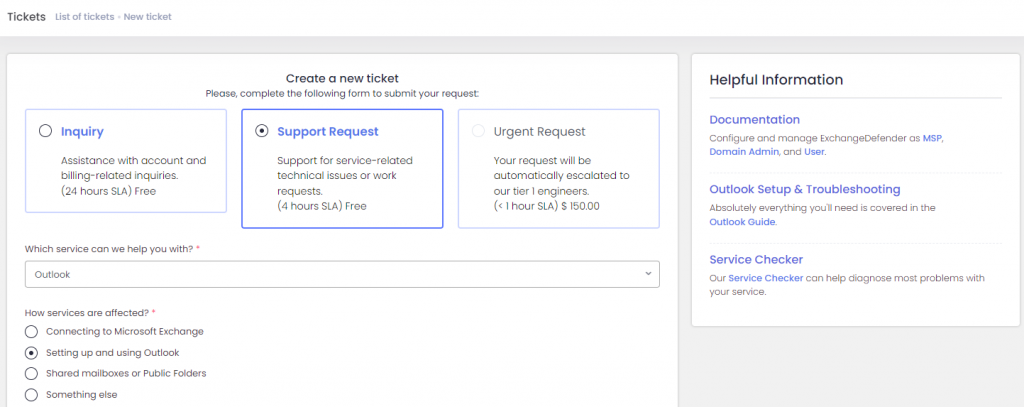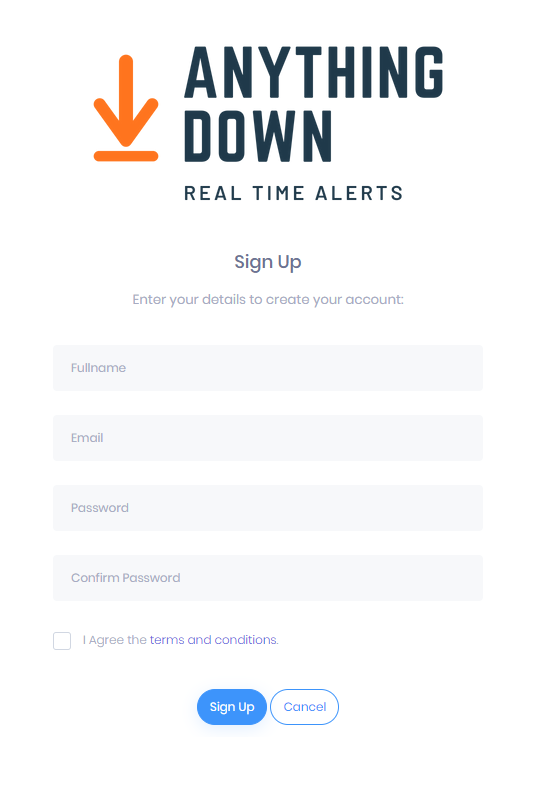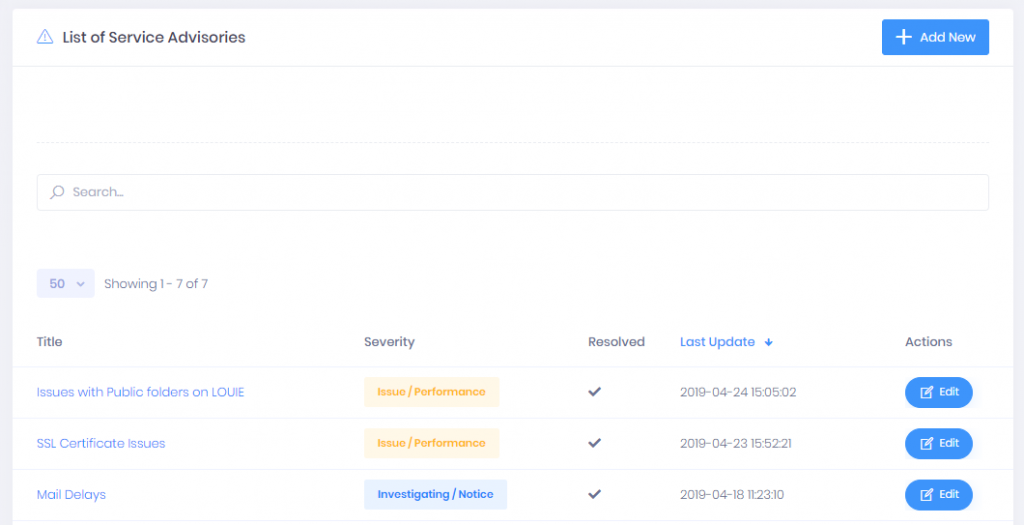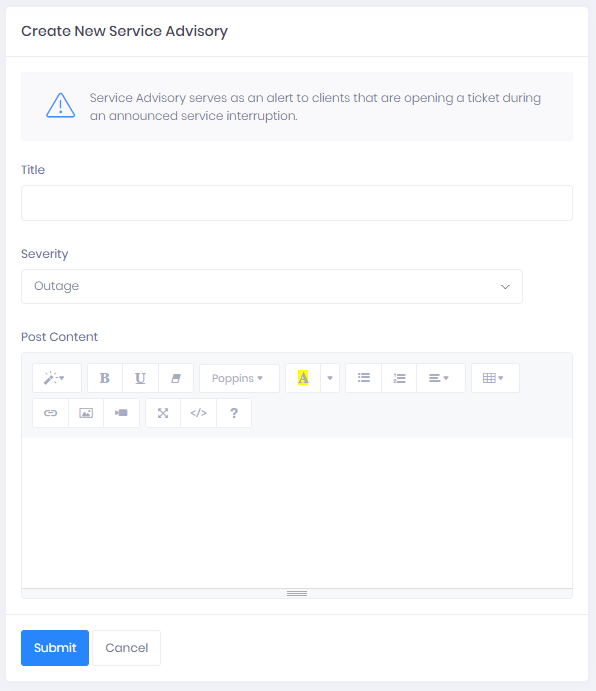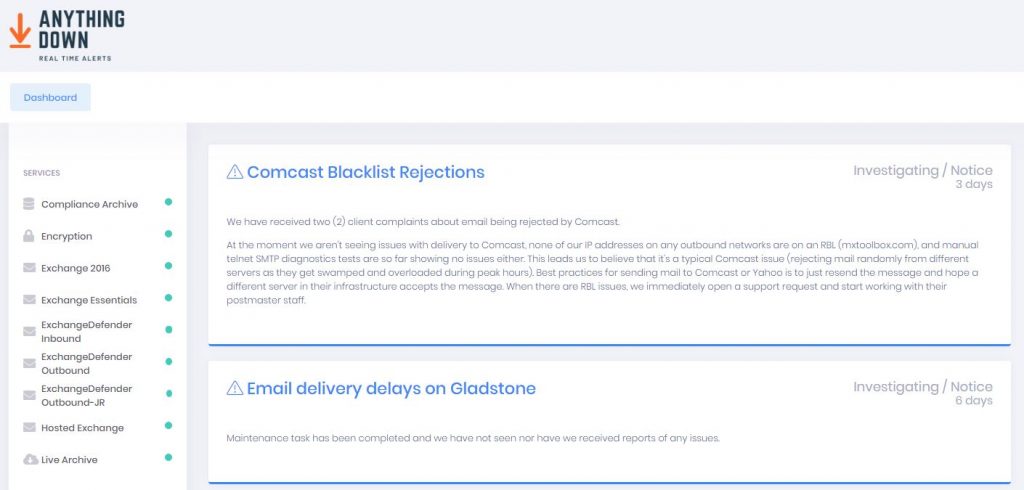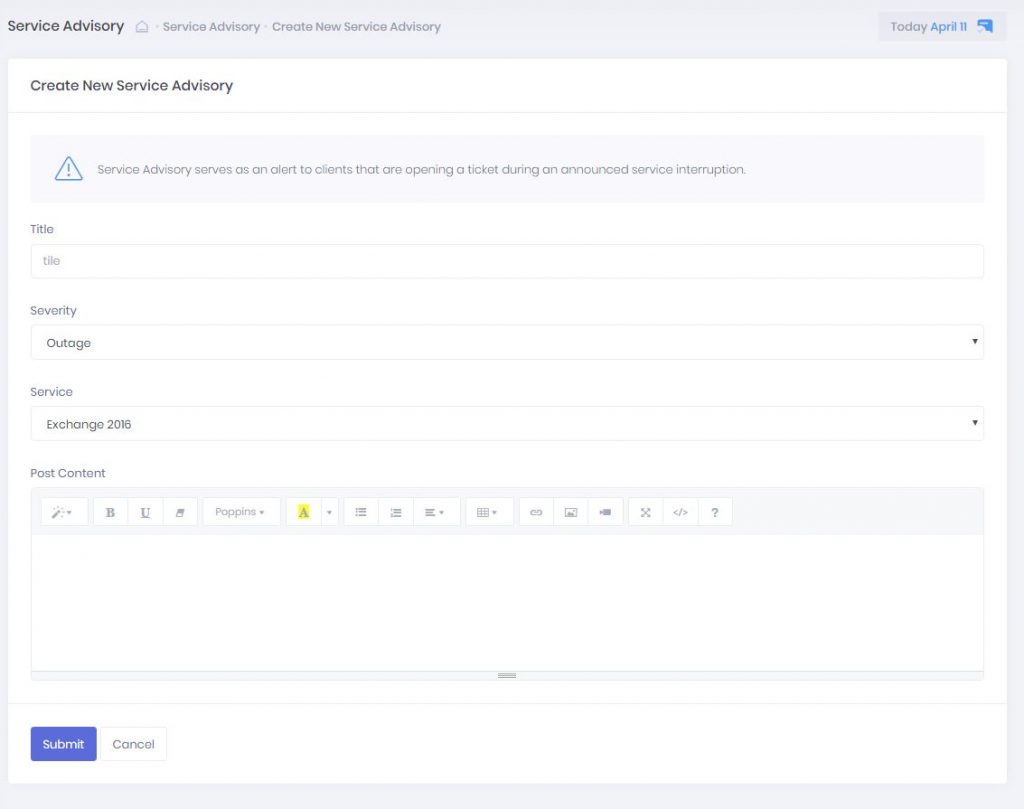ExchangeDefender Support
We are stepping up our game when it comes to ExchangeDefender support, making it faster and easier to get answers and support when you need it, how you need it.
It’s no secret that we’ve spent most of our Covid-19 time improving the user experience and making our products and services easier to use, manage, and support. We’ve upgraded documentation, our portals, our web sites, and even created automated troubleshooting apps that help you fix issues without waiting on or dealing with support.
Starting Wednesday, October 6th, 2021 the support experience will change for the better as well. Our primary goal with this update is to speed up the resolution time (time between problem being reported and it being fixed). We’re trying to create a more predictable and flexible way getting help from us regardless of how technical you are.
Enhancements
Sidebar
Over 80% of our support requests are answered by pointing users to documentation. With that in mind, we’ve redesigned the process to better identify the service, issue, and the user that is experiencing the problem. The system automatically reviews everything as you’re opening the ticket and advises if there are known issues with your account/configuration, and provides links to documentation and fixes. We expect this to be very popular with our growing service providers (we’ll train your staff for you!)
Collateral
If everything appears to be correct (we cannot replicate the issue remotely and the issue is on the client device or network that we do not have access to), the ticket process will immediately ask for additional collateral and troubleshooting info. The goal here is to collect enough information to get the issue addressed right away instead of going back and forth.
We also tried to strike a balance across our client base when it comes to technical expertise and urgency. If you have a problem that is urgent and you want us to drop everything to help you – we can do it! If you’re not very technical, or not in a rush, or don’t have the time to do diagnostics – we can help.
Summary
We’re been quite busy during Covid-19 lock/slow-down and we wanted to do something to improve the experience and quality of our technical support. The new system puts you in control of the support. You choose how urgent the issue is, how much diagnostic information you provide, and the service level you need. We’re going for a win-win with this release: giving you more control, more access, more flexibility, more documentation – and a faster resolution time for the end user.
ExchangeDefender Whitelist vs. DEA (Disposable Email Addresses)

ExchangeDefender is a cloud-based email firewall, and as such we enforce client’s policies against the only email address that is trustworthy: the envelope from address.
Over the past few years there has been a significant increase in use of disposable email addresses (DEA), specifically among mass/bulk mailing operations such as SendGrid, AmazonSES, MailJet, SMTP2Go, SocketLabs, Postmark, Mandrill, Mailgun, MailChimp, ConstantContact, etc. These email addresses, also known as “dark mail” create a unique email address to serve as the official From: line, in an effort to track bounces and delivery problems. Every time you get an email from one of these mass mailing operations the address the message actually came from is unique and generated just for that email/campaign – so whitelisting/blacklisting such addresses can be a challenge for clients that do not use ExchangeDefender’s admin portal or quarantine reports (which detect BATS/DEA addresses and auto-suggest the domain or IP to create a policy).
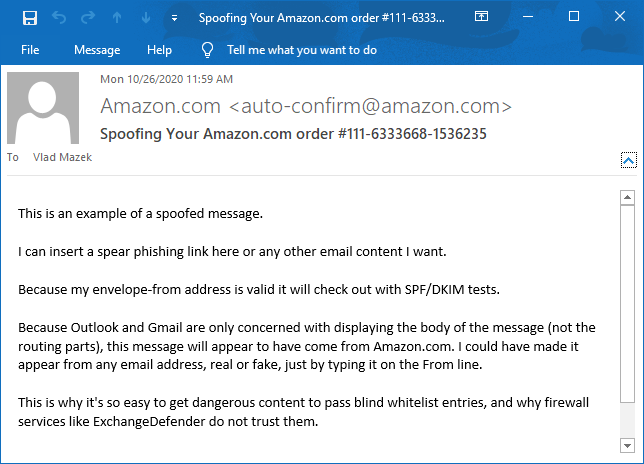
Bulk mail operations are not just used for mass marketing mail, where companies large and small do not want to build out the infrastructure to deliver tons of email. They are used for notifications, alerts, and most legitimate junk mail that you get. Unfortunately, the same companies are abused in virtually the same way by hackers to deliver spear phishing content. Because the body/header From: address can be easily faked, hackers hide behind places such as SendGrid, AmazonSES. Because they are highly automated, there is relatively little in the way of policing on these networks: after all, they make money to deliver junk mail to you and have little incentive to keep SPAM and phishing content from being sent through their networks.
Over the years, we’ve taught countless MSPs and IT people the difference between the “envelope from” (routing address) and “header or body from” (fake, but friendly looking From address displayed in your email software like Gmail or Outlook). As our client base has changed over the years, we’ve decided to write up an intro-level explanation of the process and how to master it. You can find it here:
https://www.exchangedefender.com/docs/whitelist
We hope you can use it to better block or permit access to these operations. If you’d like our assistance with this process, please open a ticket at https://support.ExchangeDefender.com and remember to attach the .eml file and/or full headers which are required for troubleshooting.
For our pro subscribers, stay tuned. We’ve been hard at work on our antispam engine enhancements and we’ll have a friendlier way to manage this by Thanksgiving 2020.
New Service Manager for Exchange 2016 – Explained!
The full migration to Exchange 2016 has proved to be extremely challenging, but with much success we are managing to move ALL of our clients hosted with us to the new platform.
New changes have occurred to our Service Manager to best compliment the new migration. Below, you’ll find explanations and screenshots of what you’ll be seeing from now on.
You can access your service manager inside our support portal via support.ownwebnow.com
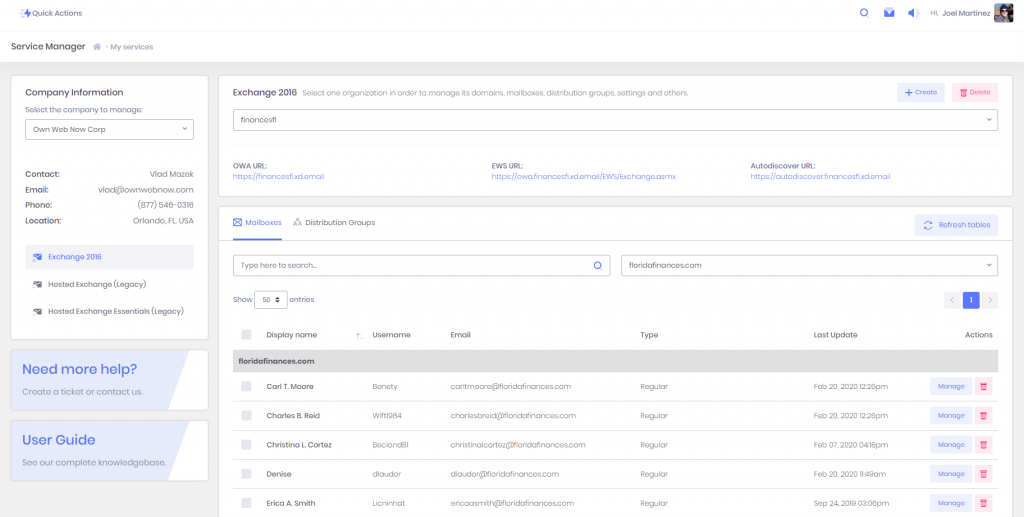
- Clients must select the organization they would like to manage
- Once they select the organization, the list with all the domains mailboxes and distribution groups under that organization will be updated below
- It is possible to search for specific accounts or filter by domain

If you click the + Create button, a list with options will be displayed:
- New organization
- New mailbox
- New domain
If you click on create organization, a pop-up window will be displayed where you would have to type the name of the organization and add as many domains as they need at once.

If you click on new mailbox, a pop-up window will be displayed where you would have to select the domain and then type all the information for each one of the mailboxes.


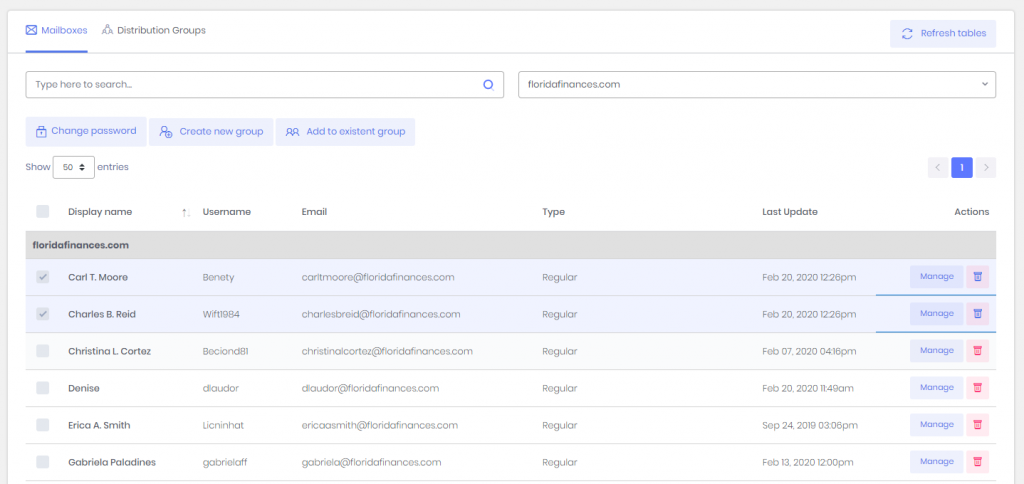
Updates are as followed:
- The list of accounts is now grouping the records by domain, and sorting them by the display name in ascending order, that way it makes it easier to find accounts when you have a lot.
- From there you can change the password of multiple accounts at a time, create a distribution group based on your selection or add the accounts selected to existing distribution groups
- You can also delete accounts
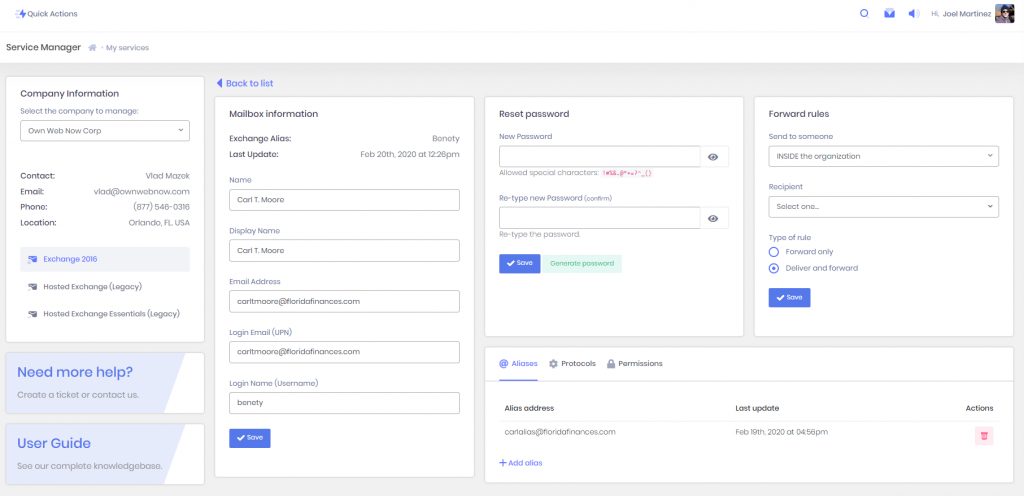
If you click on Manage, another view will be displayed with the information of the account selected. From there they can:
- Update the information of their account
- Reset their password
- Create a forward rule
- Add aliases
- Configure their protocols
- Add permission rules
From there, if they want to create new aliases they just have to click on the button +Add alias

To add an alias they will have to pick a domain, and type the local part of the email (local part of the email is everything before the @) and the alias automatically will be displayed in the table .

To update their protocols they just have to click on the switches to turn them on/off and click on save.

The permissions work pretty much the same way as aliases, with the exception that you have more options.

To add permissions, you must select the type of the permissions you would like to grant and the account (only accounts under your organization will be displayed that do not have a permission rule created for the same mailbox, that way there are no repeated permission rules for the same pair of mailboxes)

IMPORTANT CHANGES THAT COULD AFFECT THE USER’S EXPERIENCE:
- In Hosted Legacy, you could create Distribution Groups with no members and add the members later. In Exchange 2016, there cannot be empty Distribution Groups, so the only way to create groups now is checking the boxes of multiple accounts (mailboxes), and clicking on the button “Create new group”.
- In Hosted Legacy, there were no such thing as an “Organization”, in Exchange 2016 organizations were implemented to give our MSPs a way to group different entities like Domains, Mailboxes, Distribution Groups, etc under the same “Client’s structure” (organization), that way it will be for them to manage their clients since they have everything for each one of them in the same place.
- In Exchange 2016 you can create three types of mailboxes: Regular, Shared or Room (an explanation of each will be provided later).
ExchangeDefender discontinues free migrations for Office365 and Google GSuite
ExchangeDefender has assisted partners and clients with migrations from third party platforms onto our award winning platform. On July 31st 2019, we will schedule our last third party migration onto the ExchangeDefender network and will only support them under special projects going forward.
We’re sure this will disappoint some of our clients and partners that have hoped to bring their clients to our network, unfortunately this work is simply too expensive to deliver free of charge. Over the years we have given our prospects incentives – free licensing, free third party migration tools, free hosting, etc and we were able to do so on the back of deep expertise across other platforms.
But just as we continue to decommission our own older versions of Exchange clusters and third party email systems, the rest of the world is doing likewise. We feel like everyone that was truly interested in a smooth transition has made or scheduled that move already. Clients that have waited on 5+ year old infrastructure probably did so because of customized workflows, third party integrations, older versions of integrated software that doesn’t support Exchange 2016/19, etc. Keeping the immense staging, data transfer, and consulting resources on hand for legacy platforms is expensive and is needed as we roll out new features for ExchangeDefender. SplitMX, Multiroute and duplicate delivery will no longer be supported by ExchangeDefender, on our network or on Office365/Google/3rdparty.
We’ve been mentioning the sun-setting of this service since early 2018, and if we’ve missed anyone there are still 2-3 weeks during which we can swing almost anything over. Past that, we will offer migrations to ExchangeDefender as a part of our enterprise services contract.
Thank you for your business and we’ll continue working hard to keep you in love with ExchangeDefender. If you want to join the fun, let us know by August 1st, 2019.
Phishing: Beware of Strangers
This Thursday, June 6th, we will be announcing a major overhaul in the way we deal with spear phishing SPAM. No, it’s not a mind-blowing patent-pending stroke-of-genius sort of stuff, it’s much closer to what your parents told you growing up: Don’t get into a car with strangers don’t click on links or open attachments from strangers.
In a way, ExchangeDefender has had protection from this issue for years. If you had a decent IT Solution Provider implementing ExchangeDefender for you, they would have setup your SPF record and eliminated this issue – but many don’t. Or they would have turned on ExchangeDefender protection where all messages spoofing/forging your domain would automatically get junked – almost none of them do. Which is why ExchangeDefender as a service has become less of an IT tool and more of an end user suite of services to get stuff done.

When features like this are left disabled “because they might become support issues” it becomes really difficult to secure users. But I get it, IT companies have a business to run too, which is why we’ve really stepped up our support efforts and are going to be there to help folks get things done without becoming an additional problem for the IT department. Doing so has really made us rethink how we implement features and how the service behavior needs to speak the same language as the end user. Which brings me to phishing beyond forgeries.
Can you spot a stranger?One of the new phishing protection features in ExchangeDefender will allow you to flag messages that are coming from outside of your organization. You will have two settings – to modify the subject and to modify the header of the message so when you look inside of your mailbox you’ll know what came from a stranger right away. Try it:
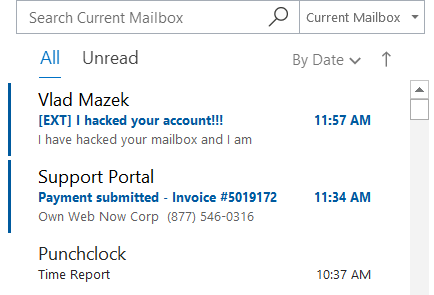
Even from the message listing you’ll know which messages shouldn’t even be opened. But suppose you ignored even that – you can set another warning, printed inside of the message, giving the user even more of an instruction of what to do.
Warning: Message was sent from outside of the organization. Do not click on links or open attachments if you don’t recognize the sender.
Far from subtle. And it has to be – because most people check email quickly, between tasks, or are simply interrupted by it. ExchangeDefender has your back, and we’ll make sure we alert you to possible issues before they become problems. Which we hope everyone will be aboard with.
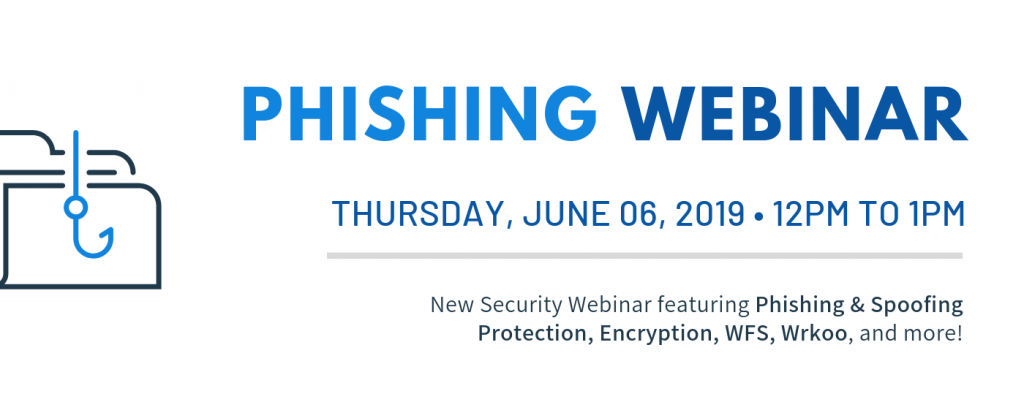
Please join us, June 6th at Noon, for our NEW webinar featuring ExchangeDefender’s Phishing and Spoofing protection, plus see what’s new with Encryption, WFS, and Wrkoo!
ExchangeDefender PTR & RBL Whitelisting

ExchangeDefender is opening a wider beta test of our whitelisting functionality, which allows IT Solution Providers to whitelist sender mail servers that have broken DNS (missing PTR, mismatched A/PTR records) and poor sender reputation (hosts listed on multiple RBL blacklists).
If you have a sender you would like to whitelist against these essential network tests, please open a ticket at support.ownwebnow.com with subject “Whitelist PTR/RBL: IP Address” and provide as much information in the ticket so we can accommodate this specific request. Only hard non-negotiable rejections to whitelist will be for unknown address space and dialup/consumer cable IP addresses (because due to their nature those are typically dynamically assigned address spaces that shouldn’t be relaying mail at all, they should be using their ISP mail server provided smarthost)
Requests will be reviewed and either approved (and enrolled) or rejected within 24 hours by our CSO.
Background: Inability to previously whitelist broken DNS and dynamic IP address space is rooted in our mission statement. We are here, beyond everything else, to help secure the email. We know our partners, IT Solution Providers, VARs, MSPs, etc do not have the skill set, the time to properly research underlying issues, enough data and statistical models to evaluate sender IP reputation, or even the incentive to discern how big of a security threat and compromise a specific IP address with broken DNS or poor reputation may pose to your client.
In fact, you pay us to worry about those things and keep your clients secure. But, sometimes clients like to think they know better than their technology experts, generally accepted security standards on the Internet, and ExchangeDefender. And the client is always right. But, when they get infected attachments, broadcast storm, password dumps, or other security compromises because they insisted on lowering their security – then ExchangeDefender is on the hook for securing them. And we don’t get to say “told you so” nor do we have any rapid means to fix the issue.
Since my retirement, all of those hard-line policies designed to keep clients safe beyond whatever “specific business case requirement” they may have, are slowly going away. Good news for the client, good news for the partners. Good news for us, because going forward we will start providing Email Security Engineering services – so when you get a security compromise or an usual issue and you’ve asked us to compromise your security – we will be able to address the issue on your behalf.
I choose to look at this as a positive – we will help our clients meet their business needs and get the mail they desperately need – and if something breaks we will be there to help assist with the cleanup (for a fee, of course). This, among many other service related things, is just the part of the ExchangeDefender being more responsive and service oriented when it comes to our clients demands as opposed to our expert opinion as a security policy.
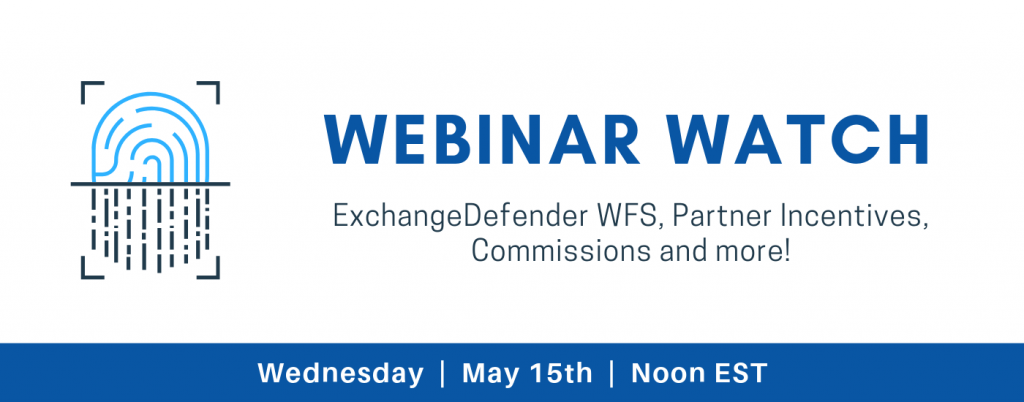
ExchangeDefender’s AnythingDown.com – See How It Works!
As promised in the last webinar, we’re moving as aggressively as possible to make sure our partners have as flexible of a tool as we can imagine to communicate with clients in the event of an IT catastrophe. Or, in our case, to further increase transparency and collaboration with all our ExchangeDefender service providers so you can get better insight into our network and when we’re dealing with a lot. That said, I believe that the product/service is now production ready and we’ve already tied it up in our ExchangeDefender Enterprise product so you’ll know as we know. 🙂
Remember, ExchangeDefender’s AnythingDown.com , or https://yourserviceproviderid.xdnoc.com – is your own brandable, real-time alert system that covers ExchangeDefender managed resources as well as your own custom defined events.
Let’s go on a little tour, shall we?
First, here is the nearly-final look of the site. It will of course feature your logo, your contact information, and your own services but you can see that there is now a sign in section as well as nested posts – so when something is updated it’s done so in-line and can be read normally (as opposed to just seeing the latest update and not knowing what it’s about at all).
Sign in screen is for you, just provide your service provider ID and password and you’re in your own portal.
As for your users that want real-time updates via email or RSS/blog, we have a signup page (I know, I know, it’s idiotic but GDPR and EU have put this obstacle in place where we need contracts and disclosures about signing up for an email list).
Once you’ve signed in as the service provider, you will have access to manage and create new service advisories. Just click on the Add New button in the upper right corner. If you’re managing a larger NOC and have a ton of fires going on (you’re among friends, #respect) you can also search current open advisories and make sure you update the correct one.
New advisory posting is pretty flexible and gives you actually quite a bit of power to include images, links, and other multimedia. As network geeks we’re used to plain text, ASCII, 80 columns across black on white kind of alerts but in the 21st century with lots of things going on sometimes you can throw out a quick alert with a screenshot of what’s going on rather than trying to document every single detail (for example, a cloud of daily network/ISP outages as an explanation why things are moving slow or getting delayed or buffered)
And of course, you can update every service advisory.
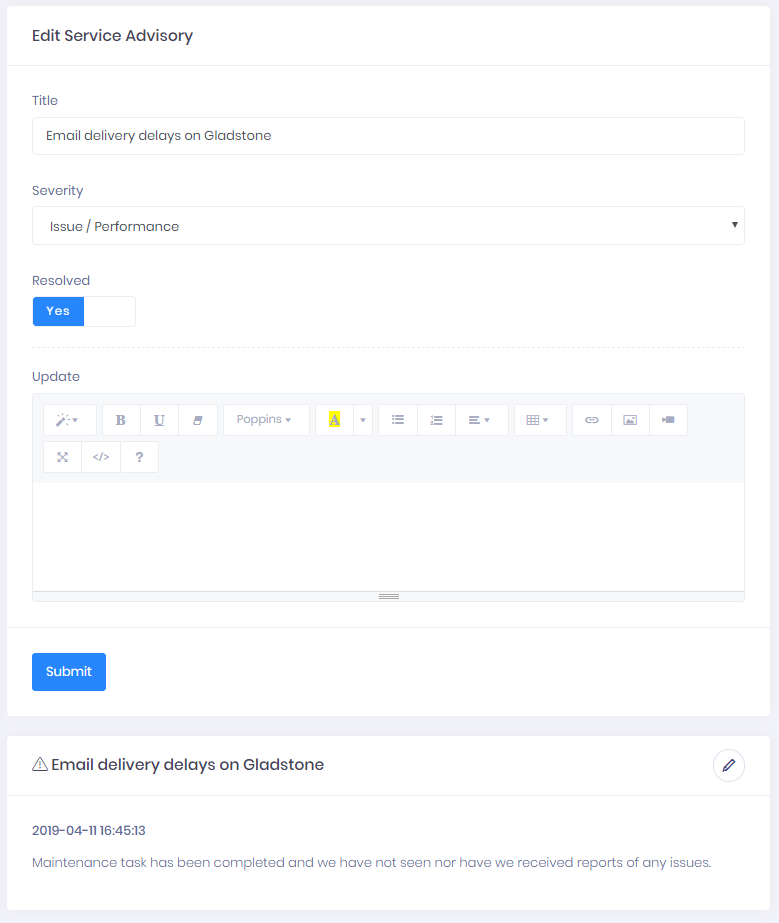
As mentioned last month, ExchangeDefender XDNOC </a> service is all about helping us work better with the people that pay us to help protect their networks and users. I have some rather personal thoughts on that subject, which will be a matter of another post. However, when you design software and when you serve as the gatekeeper, your primary responsibility to the people you’re protecting and waking up to keep safe every day is not just to keep things going but also to keep everyone aware of what is going on to improve things – because hackers don’t take days off.
Anything down? We’re improving our NOC and communications!
When things malfunction at other companies, they blame vendors and equipment. When things malfunction at ExchangeDefender, we build products and services so we never have to deal with the problem in the first place. As a result of a DDoS attack last month, I am happy to introduce you to our new service that will improve one area in which we undoubtedly suck the most: communication.
Say hello to AnythingDown.com:
It’s an offsite NOC alert site that’s branded for you.
At ExchangeDefender we do a pretty amazing job communicating and working with our partners, it’s actually our #1 selling point, that you can come to our offices and data centers, you can work with our team and get things done. But when something breaks, that same business friendliness and accessibility is an achilles heel – clients swamp the phones demanding to be briefed on every detail, “Friends of Vlad” call every staff cell phone they can find, the staff that is there to help/coordinate/assist in technical work cannot efficiently correspond and inform every user particularly when things go down and everything isn’t working as it should.
This is where ExchangeDefender XDNOC (aka “AnythingDown.com”) helps.
It’s off site. Doesn’t rely on our networks at all.
It’s on it’s own name space. Not dependent on our DNS/registrars.
It’s branded. Your name, your image, your message.
That last bit is pretty important – we realize that our larger clients have many employees that have never heard of ExchangeDefender, ditto for our partners that don’t want to reveal ExchangeDefender is behind their branded email offering.
Not to worry, your site is already branded and you have your own Service Provider XDNOC: https://<yourExchangeDefenderSPId>.xdnoc.com
It’s yours, it’s yours for free, and we’re just getting started. For the next week or two, the site will host ExchangeDefender content only as we add in the mechanism for RSS subscriptions, linking, SMS/txt alerts, and email notifications.
But this is just the beginning. As an ExchangeDefender subscriber you will have access to this site to tweak it as necessary and to add your own NOC alerts. That’s right, we’re not just building this for ourselves, we see it as a role of central accountability for everyone that relies on our services and all the services you use to deliver a solution. We all want to keep the client happy and informed and this will help out a lot towards that goal.
Our expectation is also to have our proprietary monitoring and alert feeds published on AnythingDown.com going forward so you can see or anticipate the issues that our infrastructure is seeing even before there are tickets or human confirmation of the problems. For many that will be way, way, way too much data but we feel it’s better to present it and get more eyes on it than hide it and hope it’s handled through automation or our staff activity.
In closing, I hope this helps. I know outages and service interruptions or performance issues or networking issues all suck, nobody wants them. They come with the territory and everyone knows it – so it’s not about technology malfunctions, it’s about your communication about the IT work that is done to make it as flawless as possible. We thank you for your business and for your continued support of ExchangeDefender that makes stuff like this possible.
Network Upgrades at ExchangeDefender
Many IT professionals have gone through a lifecycle infrastructure upgrade – the all important cycle of improving the infrastructure as the vendors push down new features with ever increasing resource demands. We’ve been doing that since 1997. One thing that has changed in the past 20 years is the scope and magnitude of both attacks and the network demands to manage them all. We’ve done an excellent job keeping up with them all, with our last major outage (that lasted nearly 4 hours) back in 2011. We learned a lot that day – and rolled it up into our products and services that many of our partners have experienced. These days, with the cloud services, the game is completely different.
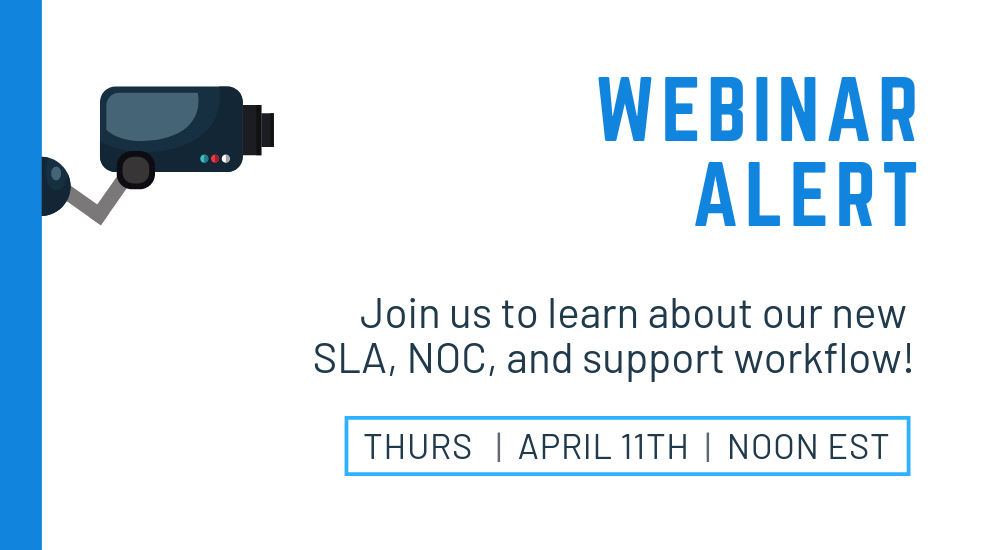
I hope you have a moment to join our WEBINAR next Thursday, April 11th, at noon
Register here: https://attendee.gotowebinar.com/register/5700720797827651073
It won’t be the usual rah-rah new features new stuff show. I will speak candidly about how we’ve managed to overcome and triumph in the “Cyber” security game and how we’re still always one step behind whatever 0-day attack vector comes down. I’ll be discussing (somewhat intimate) details about the performance issues, DNS issues, DC issues, subscription issues, 3rd party IP issues, and how all of these have become both an IT management issue and customer service nightmare. I truly hope you join us. I know your time is valuable and schedules get tight so if you can’t make it, the recording will be posted in our portal as usual.
What we learned last week – for the millionth time – is that communication in cases of issues is paramount. When things appear to go down, people panic. They require not just information but reassurance, confidence, and a plan required to address issues. For smaller companies, that’s a matter of just falling back to a cell phone – for larger ones (if it’s not already you, it definitely is something to consider for your clients) that is simply not an option and the volume of activity will easily and quickly overwhelm you. I used to see it every day – when issues come up for our partners, their clients call us.
We’ve made an overwhelming investment – not just in technology and features but manpower – that has fueled our growth for the last few years. I want to share, personally, exactly how we operate and how we’ve been able to both prioritize and execute some of the more impressive infrastructure enhancements and how they are going to be here to serve you for years when something happens.
And then I hope to offer you the same – as a token of our appreciation for your business and your loyalty through the years. Pretty excited, I hope you can join us.
Sincerely,
Vlad Mazek
CEO
ExchangeDefender
ATTN Partners: Currently Experiencing DDoS Attack (3/25/19)
We are currently experiencing a large scale DDoS attack on our network specifically our DNS servers.
Our team is working diligently to correct the issue, please stand by for more information – or give us a call (877-546-0316) if you need any assistance!
We will make sure to keep you updated via the ExchangeDefender blog, our facebook (@exchangedefender), and within the portal as access gets restored.
Thank you for your patience.






